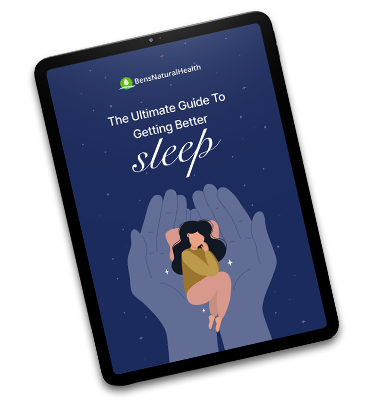With the skyrocketing popularity of milk tea, you’re probably wondering how to make your own milk tea at home.
There are several types of milk tea, and drinking it comes with potential benefits.
We discuss the benefits of milk tea and give you recipes to make your own at home.
What is milk tea?
Milk tea is any type of tea that has any sort of milk in it – it’s that simple! It can be as simple as black tea with some milk added to it or a specific drink like bubble tea, which has gained a lot of popularity in recent years.
You can use cow’s milk or any type of non-dairy milk alternative to make milk tea, which helps milk tea to fit into many types of special diets (e.g., vegan, Paleo, keto, etc.)
Get Your FREE Sleep Guide
- Learn how to naturally improve your sleep
- Dietary recommendations, supplements, and lifestyle changes
- Developed exclusively by our medical doctor
Types of milk tea
Since tea is one of the most commonly consumed beverages worldwide, you can imagine how many types of milk tea there are.
We’ll focus on some of the more common types of milk tea in this article, but know that the list doesn’t necessarily stop here!
Masala Chai (Indian spiced tea)
Perhaps one of the more well-known types of milk tea, chai tea is very popular in India but is also available around the world.
Chai tea is traditionally made with Chai tea (usually black tea) with ingredients like black pepper, ginger, cardamom, cinnamon, and clove.
It can also be made with a Chai tea mix, but that tends to be high in added sugar.
Milk (or cream) and a bit of sweetener are added to the chai tea to counteract the spiciness of the tea. It can be served hot or iced.
Thai milk tea
Thai milk tea is similar to Masala Chai, except the base is black tea or Ceylon tea, a specific type of black tea.
Other ingredients include spicy ingredients like star anise, cinnamon, tamarind, or cardamom, which are balanced with the creaminess of evaporated milk and/or condensed milk with some sugar.
British milk tea – a classic “cuppa”
The British have been adding milk and sugar to their tea as far back as the 18th century, though the rumor is that this habit originated in France.
A simple cup of hot tea with milk and sugar is how to make a standard “cuppa” British milk tea.
Turmeric milk tea (Golden milk)
This is the only type of milk tea on the list that doesn’t contain actual tea! Made with milk, turmeric, and other ingredients like cinnamon and a sweetener, golden milk can be enjoyed by people of all ages since it doesn’t contain any caffeine.
Hokkaido milk tea
The predominant type of tea consumed in Japan is green tea varieties, but Hokkaido milk tea is unique because it has a black tea base.
Traditionally Hokkaido milk tea is made with milk from the Hokkaido region of Japan but can be made with any milk as well as sweeteners such as brown sugar, honey, or even caramel.
Okinawa milk tea
Similar to Hokkaido milk tea, Okinawa tea is a blend of strongly-brewed black tea, milk, and a type of sweetener.
The thing that sets Okinawa milk tea apart from Hokkaido milk tea is the specific type of brown sugar used to sweeten it, which is from Okinawa.
Unlike traditional brown sugar (molasses added to refined white sugar), Okinawa brown sugar is made by slowly cooking down pure sugarcane juice.
Hong Kong milk tea
Very popular in Hong Kong, this milk tea is similar to other milk teas and is made with Ceylon black tea and milk, usually condensed or evaporated and not fresh milk.
Tea lattes
Tea lattes (like the famous chai tea latte) are made by mixing brewed tea with any type of milk and can be served hot or iced.
A tea latte is usually equal parts brewed tea and milk, which makes it heavier in milk than simply adding a splash of milk to brewed tea.
Bubble tea
Last but not least, bubble tea is a mixture of black tea, milk, ice, sweetener, and tapioca pearls (also called boba pearls).
Tapioca pearls are translucent pearls made from tapioca, a starch derived from the cassava root, and they need to be cooked before being used for bubble tea to give them a chewy texture.

How to make milk tea
Milk bubble tea
Since bubble tea is so popular, we’ll start with a DIY version you can make at home!
Ingredients:
- 8 bags of black tea (or 3 tablespoons loose-leaf black tea to use with a loose-leaf diffuser)
- 4 cups (~948 ml) of hot water
- 3/4 cup quick-cooking tapioca pearls
- Whole milk or milk of your choice (such as almond milk, soy milk, etc.)
- Sweetener of choice (sugar, simple syrup, etc.)
Steps:
- Prepare the tea: Steep the tea bags or leaves with four cups (~948 ml) of freshly boiled water. Let the tea sit in water until it cools completely.
- Cook the tapioca pearls: Bring about four cups (~948 ml) of water to a boil and add the tapioca pearls. Stir the pearls and wait for them to float to the top, and then cook them for another five minutes. (Test a pearl to see if it has reached the desired level of softness.)
If the pearls are still too stiff, cook them for a few more minutes. Using a slotted spoon, remove the pearls from the hot water. Quickly rinse the pearls with cold water to stop the cooking process, and then transfer the pearls into a bowl and mix them with a few tablespoons of simple syrup or sweetener to taste. - Assemble the drinks: Strain the tea into a pitcher. Divide the cooked tapioca pearls into four large glasses. Add a few ice cubes to each glass, pouring one cup of tea into each glass. Add 1 1/2 tablespoons of milk and 1 1/2 tablespoons of simple syrup (or other sweetener) into each glass. Stir and taste the milk tea, adding more milk or simple syrup to your taste.
Tip: You’ll want to serve the tea with extra wide straws (boba straws) to accommodate the tapioca pearls!
Chai tea latte
If you love the Chai lattes at Starbucks, you can make your own at home with less sugar – and for less money!
You’ll make your own Chai tea concentrate in this recipe which can be stored and used for up to two weeks!
You can always adjust the sugar content of the concentrate at home, which is a benefit since many store-bought concentrates are very high in sugar.
Ingredients:
Chai tea concentrate
- 2 cups (~474 ml) water
- 2 black tea bags (such as English breakfast) or 4 grams of loose-leaf tea leaves
- 1 tsp ground cinnamon
- 2 whole cloves
- 1/2 tsp ground ginger
- 1/2 tsp ground cardamom
- 2 tbsp. pure maple syrup
- 1/2 tsp ground nutmeg
- 1/2 tsp ground allspice
Latte ingredients
- 1/2 cup (~119 ml) chai tea concentrate from the recipe above
- 3/4 cup (~178 ml) whole milk or dairy-free milk: coconut milk, almond milk, oat milk
- 1 tbsp. pure maple syrup or honey
- Pinch of ground cinnamon
Steps:
Make the Chai tea concentrate
- Heat two cups (474 ml) of water and the spices in a small saucepan over medium heat on the stovetop. Let the ingredients simmer for five minutes. Turn off the heat and add two tea bags (or loose-leaf tea in a diffuser) and maple syrup (or honey).
- Five minutes later, pour the concentrate (hot water, spices, sweetener, and tea bags) through a fine mesh strainer and into a bowl or container.
- Reserve 1/2 cup (119 ml) of the concentrate to immediately make a latte. You can store the remaining concentrate in an airtight jar in the refrigerator for up to two weeks.
Heat the milk (optional if you want to do an iced chai tea latte)
- In a small saucepan, bring 3/4 cup (178 ml) of milk, a tablespoon of maple syrup (or honey), and a pinch of cinnamon to a slight boil. Once the sides of the milk begin to bubble, remove the pan from the heat.
- Use an immersion blender or milk frother to froth the milk (a whisk will do if you have neither).
Combine the concentrate and milk
Pour a half cup of the hot chai concentrate into a mug. Then slowly pour in the frothed milk, sprinkling the top with an extra pinch of cinnamon if desired.
If you want to drink it iced, you’ll need to chill the concentrate first or allow the freshly made concentrate and milk to cool before drinking.
What are the benefits of drinking milk tea?
Polyphenols from black tea
Milk tea is traditionally made from black tea, which contains polyphenols, a type of antioxidant that studies show can help fight inflammation.
Can be calcium-rich
If you use calcium-rich milk to make milk tea (cow’s milk, fortified non-dairy milk, etc.), then you’ll be getting a good source of calcium with your drink.
Lower-sugar option
Most milk tea recipes call for sweeteners, but you can adjust the amount to make it lower in sugar, putting the control in your hands.
Conclusion
Milk tea is a beverage made with tea and milk, which encompasses several varieties inspired from all around the world.
We shared different recipes on how to make your own milk tea at home.
Explore More








